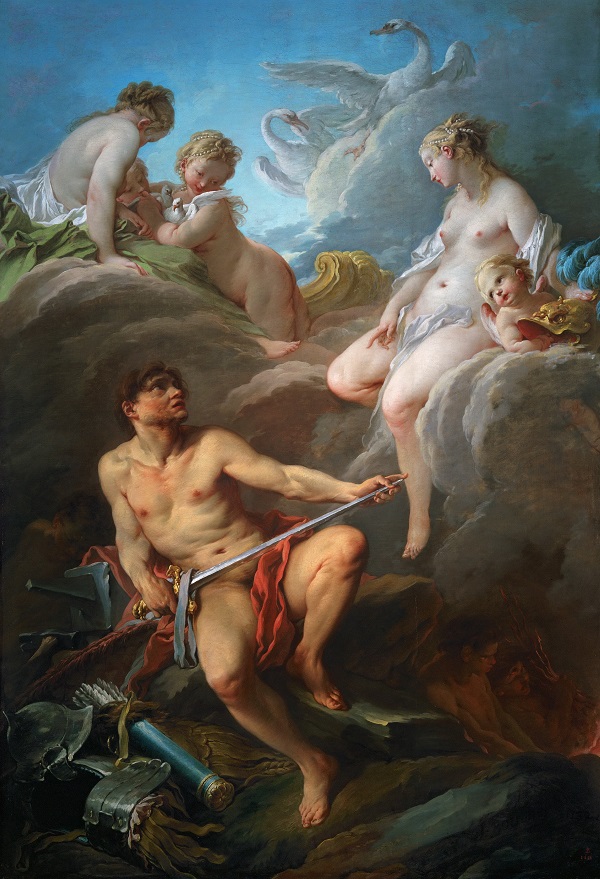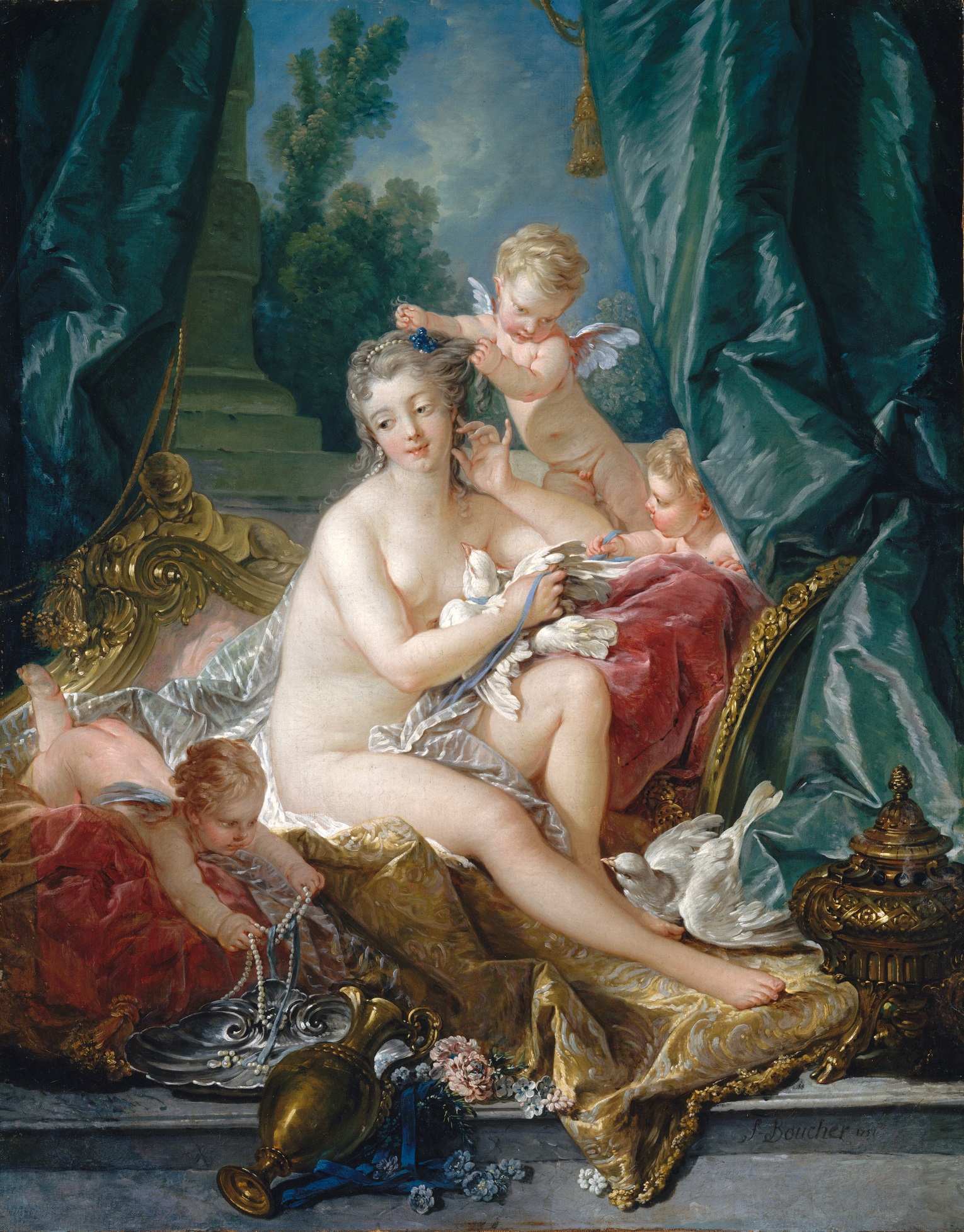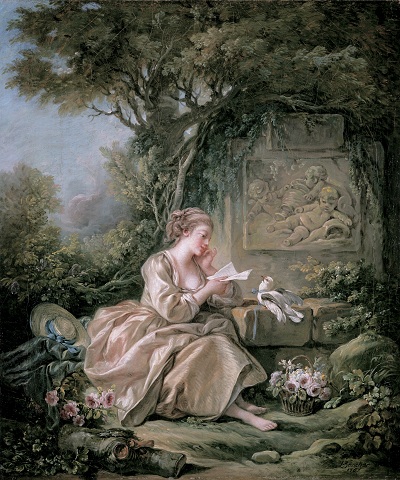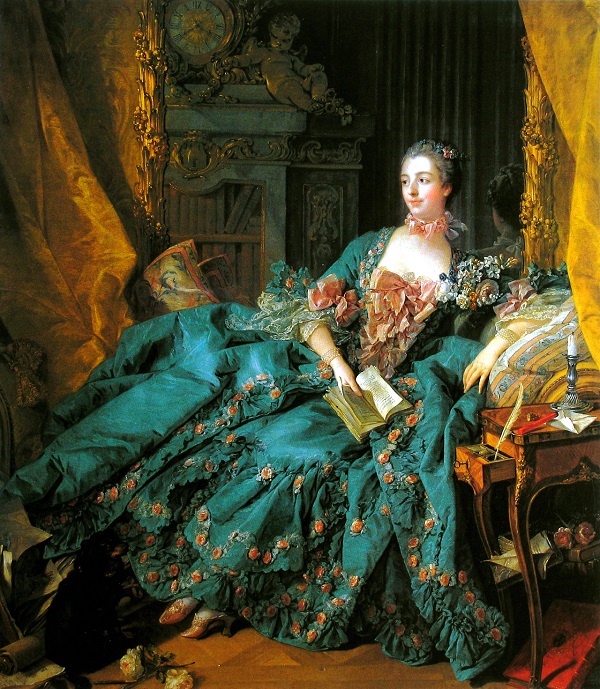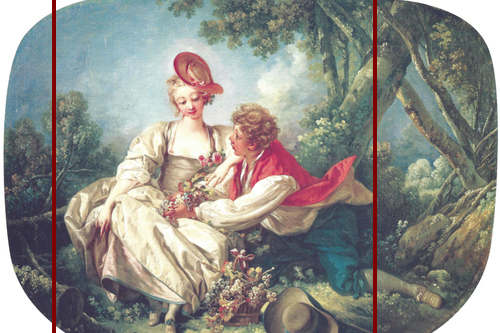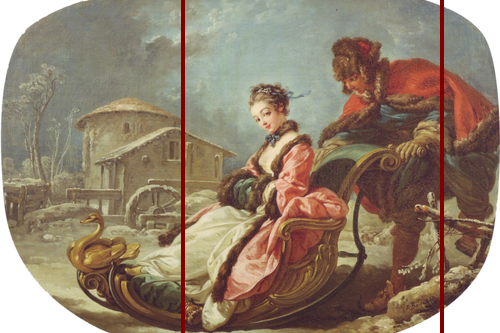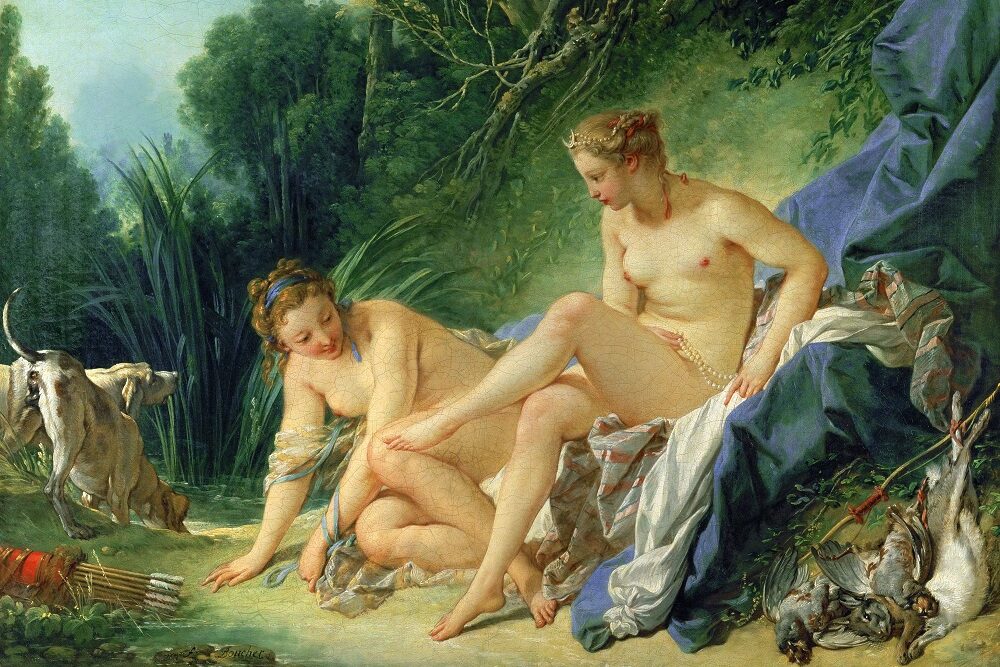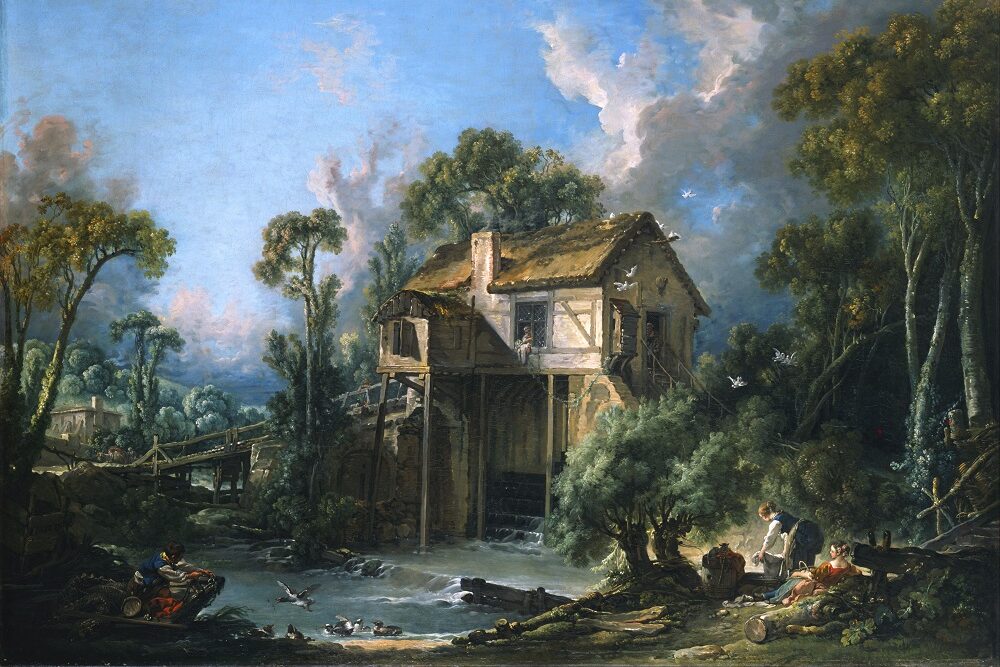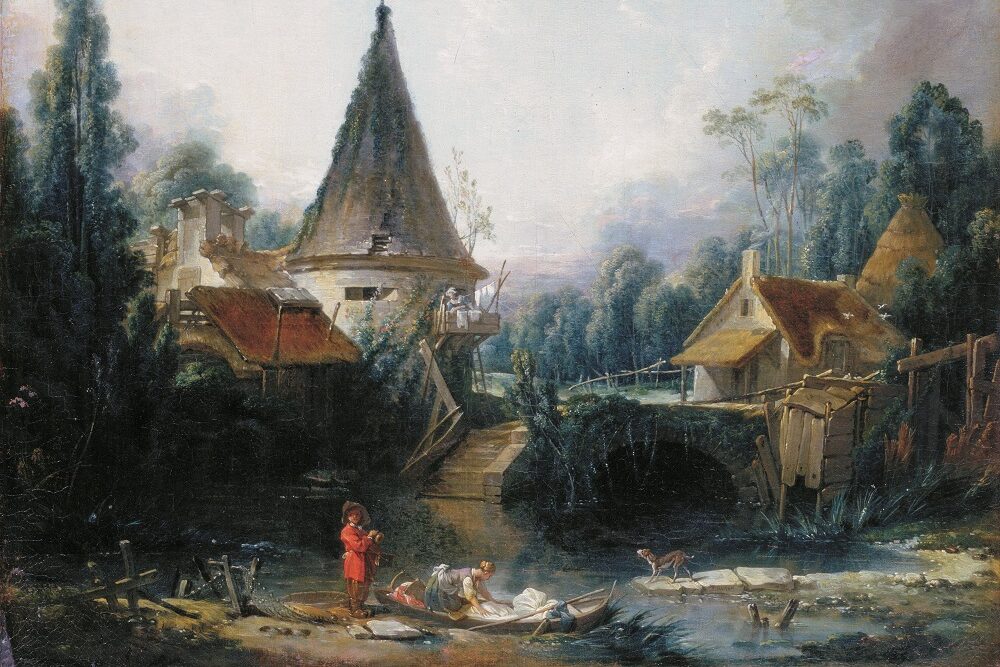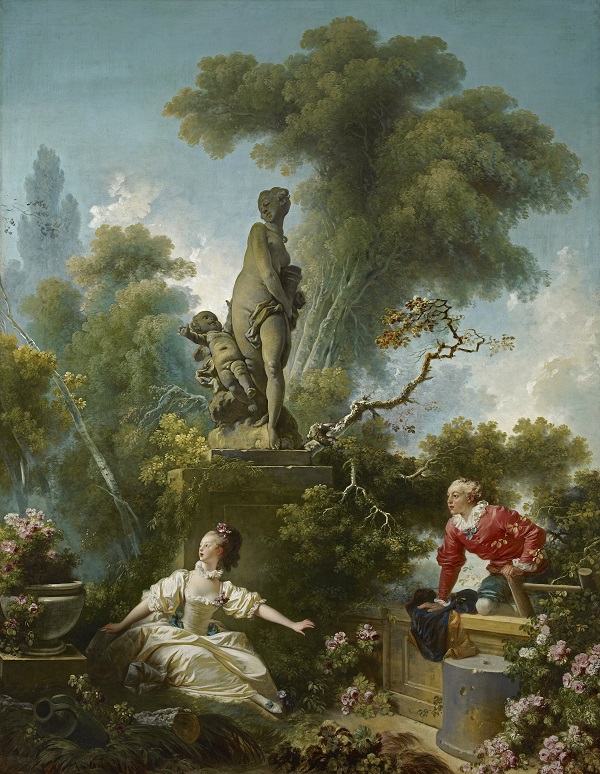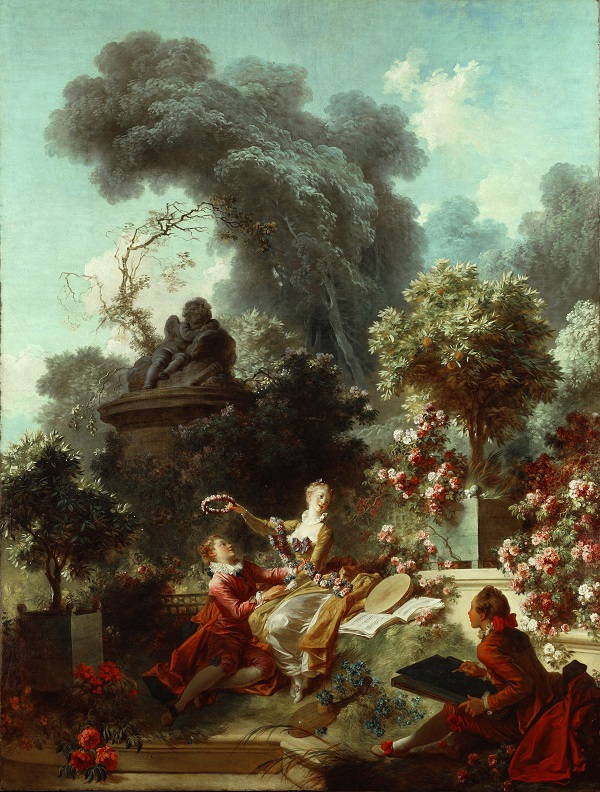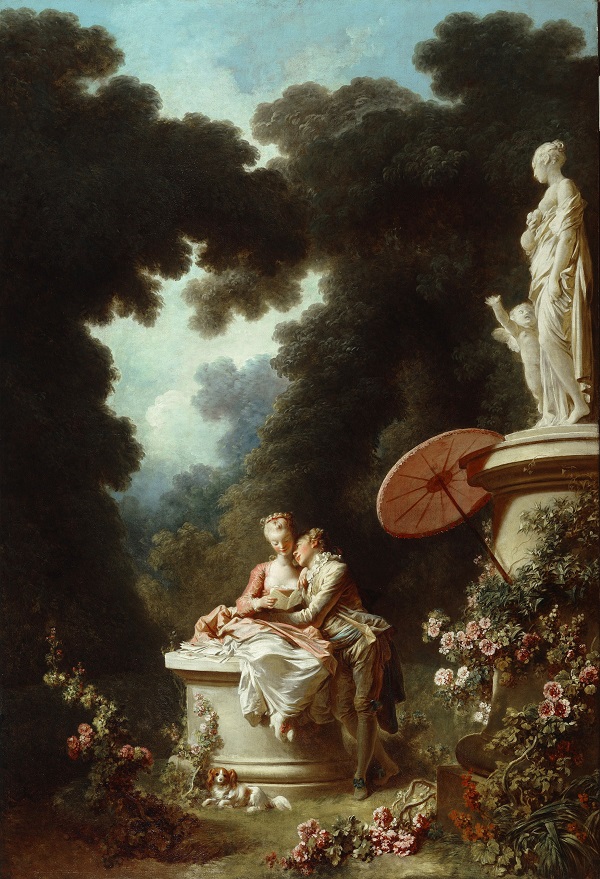This post is a series of images featuring French paintings in the Rococo style, a style that was popular among the aristocracy in 18th century Europe.
The aim of this site is to reveal the beauty hidden in images found on the internet. In particular this post is concerned with revealing the beauty of paintings in the Rococo style. Click the image that interests you. It will expand and scroll view automatically. While viewing, click control tabs on the upper left corner of the screen to (1)fast scroll (skip button), (2)expand, (3)minimize, (4)shift right or left, (5)pause or (6)scroll up or down. Details difficult to see in normal viewing will appear and this will reveal beauty hidden from you before. Enjoy !
The Rococo style emerged in France in the 1730s and was characterized by lighthearted, sensious, slightly erotic treatments of mythological and courtship themes. It’s patrons were the French nobility etc. under king Louis XV (1710-1774) and the paintings featured idealized aristocrats, mythological figures in gorgeous attire in dreamlike surroundings that only the very rich could imagine. The gulf between peasant class and nobility was vast and would lead to the French revolution (1789-1799).
The art of François Boucher (1703–1770)
There were two greats in the Rococo style and one was François Boucher.
Boucher was the son of a little known painter Nicolas Boucher and a native of Paris. His father was his first teacher in the arts. At 17 years of age, he went to work for Jean-François Cars, a french engraver, printer publisher from Lion. In 1720 he won the Grand Prix de Rome for painting and went to Italy to study. Upon his return, in 1731 he was admitted to the “Royal Academy of Painting and Sculpture”, the premier art institution of France at that time. Boucher became a faculty member in 1734 and finally “First Painter of the King” in 1765. He died in 1770 in Paris.
Boucher is one of the premier figures in Rococo style painting together with his patron Madame de Pompadour, mistress to French king Louis XV.
- Venus Asking Vulcan for Arms for Aeneas, 1732. This is a painting in Rococo style celebrating the founding of Rome. In the painting the Roman goddess Venus is asking the war god Vulcan for armour for her son Aeneas, so that he can go to war. Aeneas won and this lead to the founding of a Trojan settlement on the Tiber. It is said the Romans descended from that settlement.
- The Toilet of Venus, 1751. This was commissioned by Madame de Pompadour. It celebrates the beauty of the Roman goddess Venus. A nude Venus with doves in her hand is being attended by three cupids. There is a garden in the background. The lighthearted and slightly erotic feel is typical of the Rococo style. This was a change from the Baroque style which preceeded it with it’s sense of massive scale and volume. In contrast the Rococo style was about lightness and playfullness.
- The secret message, 1767. This painting shows a young girl reading a message from a lover. The soft colors and curves that glimmer are typical of the Rococo style.
- Portrait of Madame de Pompadour (1721-1764), dated 1756. The subject Madame de Pompadour, official mistress of king Louix 15th and patron to Boucher was one of the most influential women in Europe at that time. In the painting, the dog Mimi at her feet symbolizes loyalty and fidelity. So this is her proud statement that she is loyal to the King and his mistress.
Multiple series of paintings titled “The four seasons” exist. The above are by François Boucher and depict the changing seasons. “Benign in Spring, rich in Summer, somber yet fruitful in Autumn, and cruel in Winter.”. The paintings were commissioned by Madame de Pompadour, the mistress of King Louis XV and patron to Boucher.
- The Four Seasons: Summer, 1755. The “Summer” painting features attributes associated with the rich warm summer season, such as fruits, wheat, and young women in dishabille in a cooling bath.
- The Four Seasons: Autumn, 1755. The “Autumn” painting signifies the grape harvest, the abundence of autumn.
- The Four Seasons: Winter, 1755. This painting depicts the contrast between the harshness of winter and the glowing loveliness of the woman. The woman is said to be the mistress of Louix XV, Madame de Pompadour.
- Diana leaving her Bath, 1742. The painting depicts the Roman goddess of the hunt Diana and her attendant the nymph bathing after a hunt. The contrast between the innocent beauty of the women and the doves killed brutally in the hunt strikes the heart. Innocense versus reality. Such was the art of Boucher.
- The Mill at Charenton, 1758. A “better than true” scene painted by Boucher in Rococo style. It depicts a mill at the meeting point of the Seine and Marne rivers, a place which would have been suitable in the 18th century for French aristocrats to meet and enjoy the country life away from Paris. The mill features costly glass windows which would not have been typical for mills of that period, white doves are flying arround and the peasants are handsome and well dressed. This is an idyllic scene crafted for the consumption of the very rich. Even in his lifetime some critisised his work as overly affected and superficial.
- Landscape near Beauvais, 1740s. The painting shows a serene landscape near Beauvais, France, 75 kilometers north of Paris.. A man in red coat looks at a woman washing clothes. A “better than true life” scene. The warm colors and soft brushstrokes generate a feeling of peace and harmony that is typical of Boucher’s Rococo style. It was produced by Boucher while he was working at the Beauvais Manufactory (1743-1755).
The art of Jean-Honoré Fragonard (1732–1806)
Fragonard was the “other” great Rococo artist.
Jean-Honoré Fragonard was born in Grasse, France and was the only child of François Fragonard, a glover, a maker of gloves. Briefly, he apprenticed to a Paris notary, but showed great talent for art and was taken to the great François Boucher at the age of 18. In 1752 Fragonard won the Prix de Rome, a French scholarship for arts students and was given the chance to study in Rome, In that period he copied multiple paintings, mainly by Roman Baroque artists and also learned to appreciate Duch and Flemish masters such as Rubens and Rembrandt. He returned to Paris in 1761 and king Louis XV bought one his paintings. He was granted a studio in the Louvre Palace and was accepted as an Academician. Fragonard had hesitated between which genre to choose (religious, classic history paintings, etc.). Now there was demand from wealthy art patrons in Louis XV’s court. He turned towards them and concentrated on playfull love scenes that were slightly erotic in the Rococo style. It was only the brilliant artistry of his paintings that made them acceptable as art. The Swing, Blind Man’s Bluff are examples of his work in that period. After this the French Revolution came and Fragonard, closely associated with the French aristocracy lost many of his patrons. After the Revolution, he held administrative positions at the Louvre, but his work was no longer favoured and he died in obscurity in 1806.
In private life in 1769, he married Marie-Anne Gérard, a painter of miniatures and had a daughter, Rosalie Fragonard. Rosalin became his favourite model but died in1788. In 1775, Marie-Anne Gérard’s mother died and her younger sister Marguerite Gérard, came to live with them in the Louvre, She became Fragonard’s student and assistant and lived with them for many years and became an accomplished French painter in the Rococo style. In 1780, he had a son, Alexandre-Évariste Fragonard (1780–1850), who also became a talented painter and sculptor. His familly obviously benefitted from association with Fragonard and his artistic friends. Fragonard must have been proud.
To sum up, Fragonard was one of the great Rococo painters of the 18th century France. His style was primarily based on the style of Rubens, was not fussy but vigorous, rapid and fluent unlike that of many of his contemporaries.
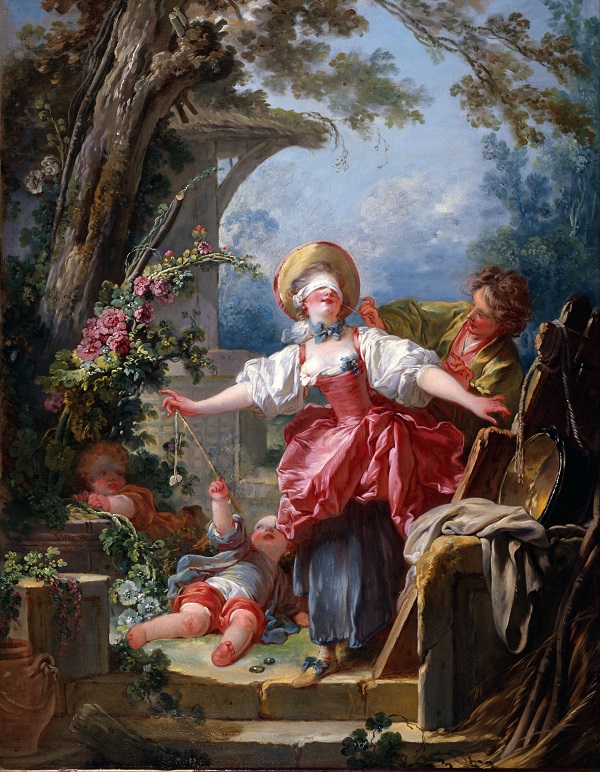
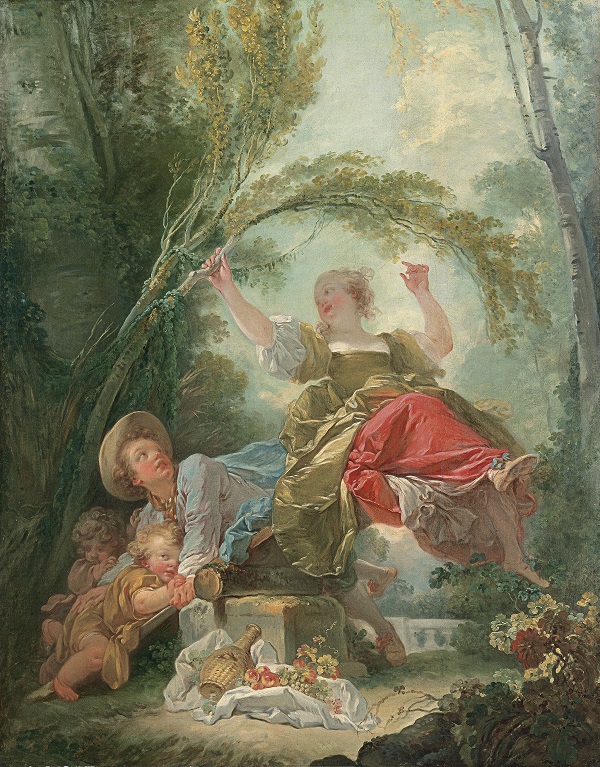
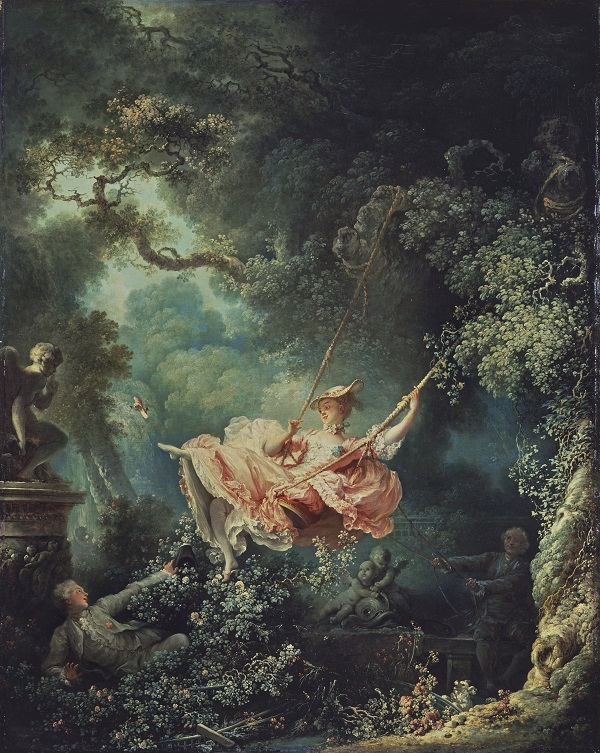
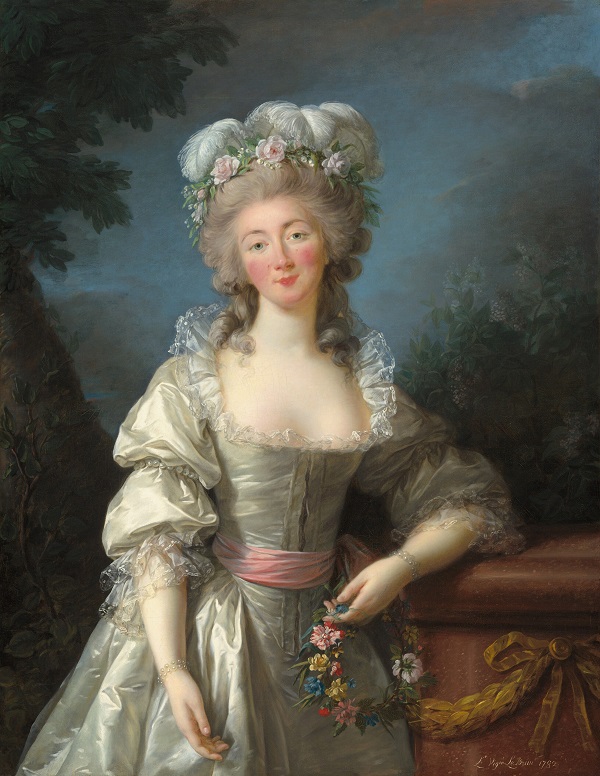
- Blind-Man’s Buff 1750-52. In 18th century France, Blind Man’s Buff was a metaphor for courtship or flurtation among the aristocracy. Fragonard’s painting is playfull, faintly erotic, sensuous. It satisfied the aristocratic taste for romantic play. The figures are dressed in peasant clothing that are too clean and fashionable. They are aristocrats masquerading as peasants. Also the young woman who is doing the chasing is not really blind. She is can see under her blindfold and capture her man when she wishes. It is all romantic playacting. This type of painting was popular among the rich in 18th century France.
- The See-Saw 1750-52. Children are playing with a See-Saw. This painting was a companion to “Blind Man’s Buff” above. Blind Man’s Bluff was about courtship, The See-Saw is about play. It suggests that the courtship has ended and the man and woman have started playing in earnest. The rocking motion of the seesaw implies that the relationship has been consummated. This painting is considered by some to be a prelude to The Swing.
- The Swing 1767-68. This painting is considered, one of the great masterpieces of the Rococo era and is Fragonard’s best-known work. A young woman wearing a lovely pink dress sits on a swing and flings up her leg so her slippers fly off. A lover hidden in the shadows is treated to a tantalizing glimpse of her legs and thighs. Meanwhile her elderly husband on the right unaware of the dalliance pushes the swing. This is a naughty painting, somewhat playful, somewhat erotic, frivolous. Not like traditional somber historic paintings which celebrated the valor and holiness of the great in history or legend. This painting and others from that period was pivotal for Fragonard. He realized there was a market for this kind of painting and he transissioned from a history painter to a more relaxed style (the Rococo style) which featured playful, slightly erotic scenes such as the one in this painting. It was too frivolous to be shown in a formal palace but could be displayed in the private rooms of the very rich.
- Madame du Barry 1782. This painting is by Élisabeth Louise Vigée Le Brun (1755–1842). The subject Madame du Barry was the last official mistress of king Louis XV. She was brought in 5 years after the death of her predecessor Madame de Pompadour. This created quite a stir beacause she was a prostitute of low birth and only 25 years old while the king was in his 50s. She was guillotined in 1793 during the French Revolution. The mistresses of the king often acted as patrons of art in that period and she commisioned the 4 paintings in “The Progress of Lover” series from Fragonard to decorate her Louveciennes pavilion.
The Progress of Love: This is a 4 painting series that depicted the 4 stages of love. The pursuit of a misstress by her lover, the meeting, the consummation and the happy ending. It was the Comtesse du Barry, the last mistress of king Louis XV who ordered it from Fragonard. It was intended for a pleasure pavilion she commissioned from the architect Claude-Nicolas Ledoux. However the Comtesse returned the paintings. The paintings were beautiful but it is said that the resemblence between the lover begging for love and the French king was too embarassing. It was too much like the French king was her lovestruck servant.
- The Pursuit 1771-1772. A typical Rococo painting by Fragonard. It is a warm and pleasant day. The sun shines. Three young girls are playing in a pleasure garden but the lead girl discovers a boy hidden behind some bushes. She starts fleeing and the other girls ape her. But the boy is quite handsome and he has a rose in his hand. Maybe he is good boyfriend material? This is the start of the romance.
- The Meeting 1771-1773. The romance progresses to a furtive meeting of the lovers. The boy scales the walls of a garden to meet the girl. The girl seems willing. The statues of the goddess of love Venus and her servant Cupid watches from above.
- The Lover Crowned 1771-1772. In the 18th century, the phrase “the lover crowned” implied marriage and consummation of a marriage. Note that there is an artist on the lower right side making a record. So the lovers are affirming the permanance of their love by having the artwork created.
- Love Letters 1771-1772. A boy looks at his lady passionately. The lady reads. She is probably reading his love letter. There is a pile of unread love letters nearby for future reading. This is a scene of absolute love. There is a small spaniel at the lady’s side indicates the lovers’ fidelity. The aftermath of love is royalty, undying lover to each other. A statue of the love goddess Venus stands as if affirming their love.
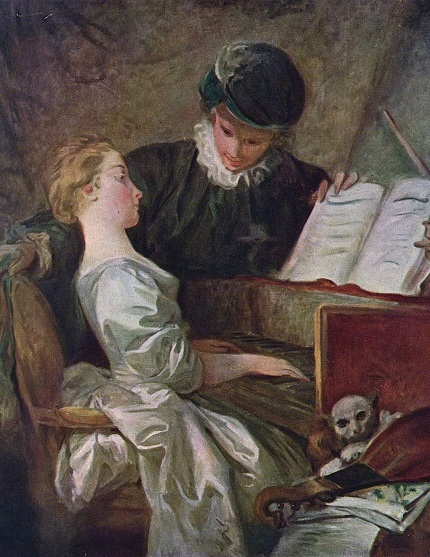
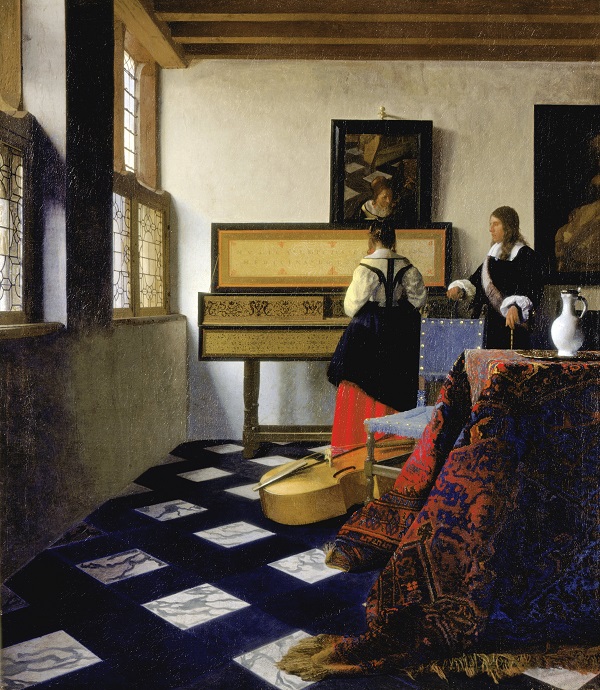

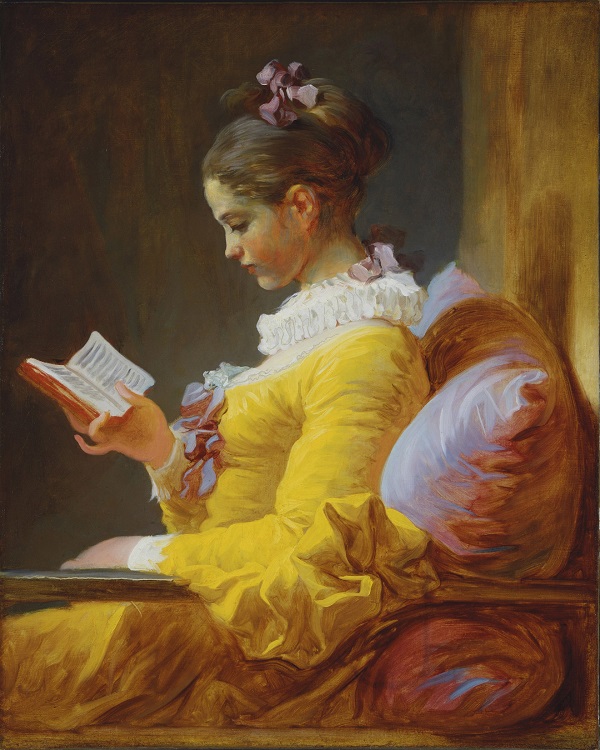
Some variations on the same theme (Music Lesson) through the ages (from 1662 to 1769 to 1892). From Vermeer to Fragonard to Renoir
- Music Lesson 1769. A music teacher is admiring a girl’s cleavage while teaching. Fragonard has created a tranquil love scene. This kind of quiet domestic painting was frequent in the paintings of the Dutch Golden Age and Fragonard took his queue from this.
- The Music Lesson 1662. A famous painting in the Dutch golden age by Dutchman Johannes Vermeer. The theme is basically the same as “Music Lesson” by Fragonard but it is years earlier. A young female is playing a virginal during a lesson with a male teacher. The teacher listens attentively. The implication is that there is a relationship between the two which is composed of love and music.
- Young Girls at the Piano 1892. This painting from a period of time later than Fragonard is by the great Impressionist painter Pierre-Auguste Renoir. It is the same domestic theme. It depicts two young girls at a piano in a rich man’s home. It is said that Renoir admired Fragonard’s use of light and colour and Fragonard’s influence can be seen in this painting.
A similar theme
- A Young Girl Reading 1777- 1776. This is one of the most popular of Fragonard’s works. This Rococo painting depicts a young woman lost in the world of books, oblivious to her surroundings. Simple, elegant and sweet. At the time this work was created, the frivolity and lightheartedness of the Rococo style was going out of favor and being replaced by the more serious, somber Neoclassical style. Fragonard never completely embraced Neoclassicism but it’s influence is clear.
Notes
The comments above reflect only the thoughts the administrator had while viewing the images. They might or might not be comments by the subjects or the photographers etc.. Please excuse any inaccuracies. You are welcome to leave comments in the comment space. Otherwise send messages to “kohi@scroll.kohibiz.com”.
The images are from https://commons.wikimedia.org/. The images are believed to be free of any royalty issues. If there are any problems please leave a message. Images will be taken down if necessary. Many thanks to wikimedia, the photographers etc. for making these superb images available. Some images have been cropped from the original using the Vertical Scroller application program. This is to ensure the best viewing experience.
